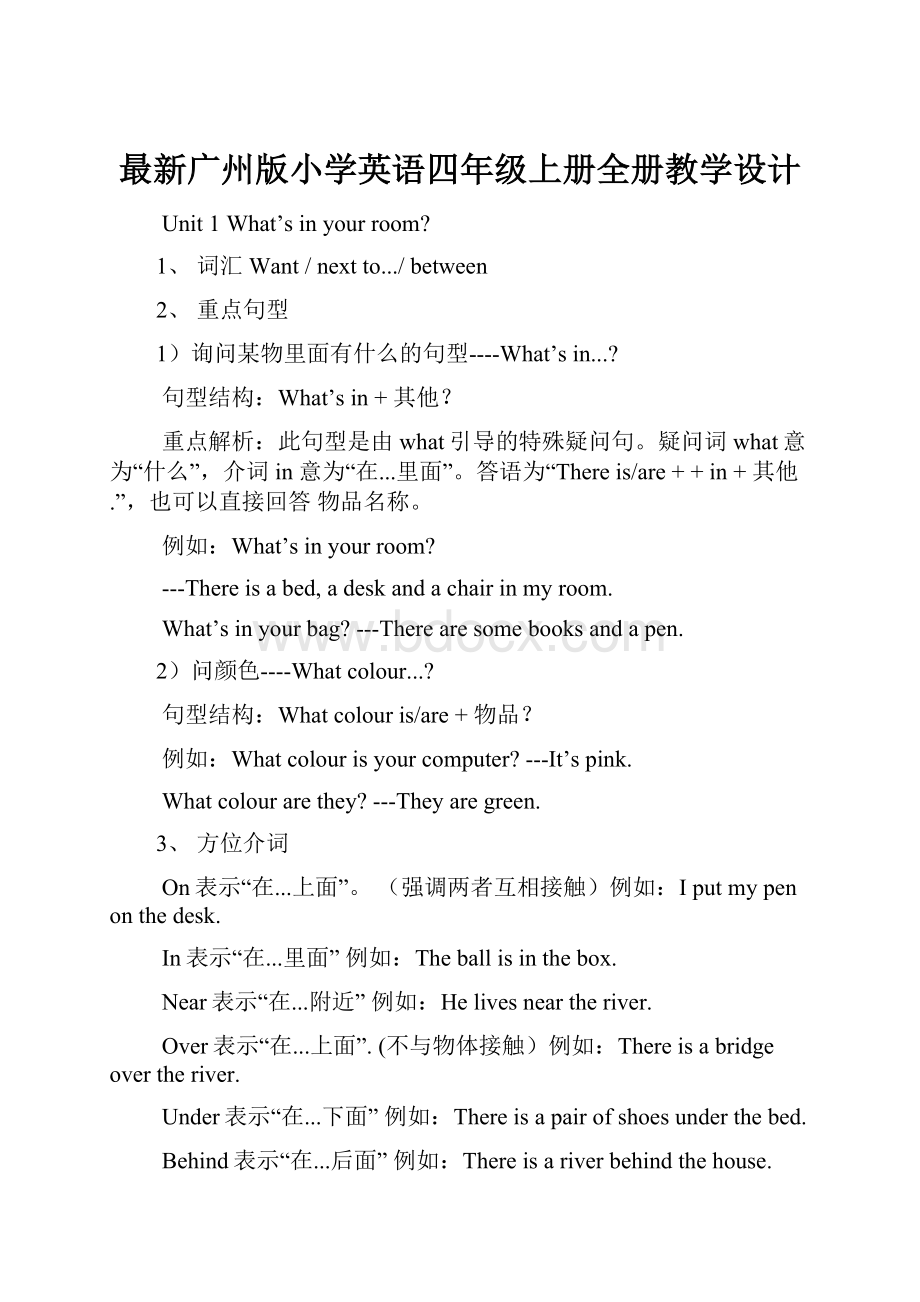最新广州版小学英语四年级上册全册教学设计.docx
《最新广州版小学英语四年级上册全册教学设计.docx》由会员分享,可在线阅读,更多相关《最新广州版小学英语四年级上册全册教学设计.docx(51页珍藏版)》请在冰豆网上搜索。

最新广州版小学英语四年级上册全册教学设计
Unit1What’sinyourroom?
1、词汇Want/nextto.../between
2、重点句型
1)询问某物里面有什么的句型----What’sin...?
句型结构:
What’sin+其他?
重点解析:
此句型是由what引导的特殊疑问句。
疑问词what意为“什么”,介词in意为“在...里面”。
答语为“Thereis/are++in+其他.”,也可以直接回答物品名称。
例如:
What’sinyourroom?
---Thereisabed,adeskandachairinmyroom.
What’sinyourbag?
---Therearesomebooksandapen.
2)问颜色----Whatcolour...?
句型结构:
Whatcolouris/are+物品?
例如:
Whatcolourisyourcomputer?
---It’spink.
Whatcolourarethey?
---Theyaregreen.
3、方位介词
On表示“在...上面”。
(强调两者互相接触)例如:
Iputmypenonthedesk.
In表示“在...里面”例如:
Theballisinthebox.
Near表示“在...附近”例如:
Helivesneartheriver.
Over表示“在...上面”.(不与物体接触)例如:
Thereisabridgeovertheriver.
Under表示“在...下面”例如:
Thereisapairofshoesunderthebed.
Behind表示“在...后面”例如:
Thereisariverbehindthehouse.
Infrontof表示“在...前面”例如:
Thereisabigtreeinfrontofthehouse.
Nextto...在旁边例如:
Thereisabednexttothewindow.
Between在(两者)之间例如:
Thereisachairbetweenthedoorandthewindow.4、语法:
be动词的用法和区别
therebe句型和have/has的用法区别
1、Be动词
Be动词:
am、is、are
口诀:
我用am,你用are,is用在他她它,复数全用are。
例题:
1.I______aboy.______youaboy?
No,I_____not.
2.Thegirl______Jack'ssister.
3.Thedog_______tallandfat.
4.Thejeans______onthedesk.
(一)、有be动词的肯定句和否定句
IamfromLondon.IamnotfromLondon.
Heisateacher.Heisnotateacher.
Sheisinthediningroom.Sheisnotinthediningroom.
Myhairislong.
Myhairisnotlong.
Hereyesaresmall.
Hereyesarenotsmall.
归纳:
在有be动词的句子中,改否定句时只要在be动词______加上_____。
(二)、有be动词的一般疑问句
AmIaChinese?
Yes,youare.No,youaren’t.
AretheyAmerican?
Yes,theyare.No,theyaren’t.
Isthecatfat?
Yes,itis.No,itisn’t.
(三)、综合练习
用恰当的be动词填空。
1.Themanwithbigeyes_______ateacher.
2.______yourbrotherintheclassroom?
3.Where_____yourmother?
She______athome.
4.How_______yourfather?
5.MikeandLiuTao______atschool.
6.Whosedress______this?
7.Whosesocks______they?
8.That______myredskirt.
9.Who______I?
10.Here______ascarfforyou.
2、Therebe
(1):
therebe句型基本认识
1、定义:
Therebe句型表示某处存在某物或某人。
2、结构:
(1)Thereis+单数可数名词/不可数名词+地点状语.
(2)Thereare+复数名词+地点状语.
注意事项:
there是引导词,在句中不充当任何成分,翻译时也不必译出。
句子的主语是某人或某物,谓语动词be要与主语(某人或某物)的数保持一致。
当主语是两个或两个以上的名词时,谓语动词要与跟它最近的那个名词一致。
如:
①Thereisabirdinthetree. 树上有一只鸟。
②Thereisateacherandmanystudentsinourclassroom. 我们教室里有一位老师和许多学生。
③Therearetwoboysandagirlunderthetree.树下有两个男孩,一个女孩。
(2):
therebe句型的常考点
1:
变成否定
Therebe句型的否定式的构成和含有be动词的其它句型一样,在be后加上not即可。
例如:
例1:
Therearesomepicturesonthewall.
=Therearen'tanypicturesonthewall.
例2:
Thereisabikebehindthetree.
=Thereisn'tabikebehindthetree.
2:
变成一般疑问句
Therebe句型的一般疑问句变化是把be动词调整到句首,再在句尾加上问号即可。
但同时要注意:
当肯定句中有some时,要将其改为any(否定变化也一样)。
some用于肯定句,any用于否定或疑问句。
ThereissomewateronMars.→IsthereanywateronMars?
Therearesomefishinthewater.→Arethereanyfishinthewater?
3:
特殊疑问句
对主语提问:
当主语是人的时候,则用who引导,当主语是物的时候,则用what引导。
注意:
无论原句的主语是单数还是复数,对之提问时一般都用be的单数形式(回答时却要根据实际情况来决定)。
如:
Therearemanythingsoverthere.→What'soverthere?
Thereisalittlegirlintheroom.→Whoisintheroom?
对地点状语提问:
则用where引导。
如:
Thereisacomputeronthedesk.→Whereisthecomputer?
Therearefourchildrenontheplayground.→Wherearethefourchildren?
对数量提问:
般有两种句型结构:
Howmany+复数名词+arethere+介词短语?
Howmuch+不可数名词+isthere+介词短语?
2、Have/has
1、定义:
指的是主观上的“拥有;持有”,表示某人拥有某物,是一种所属关系
2、结构:
主语+have(第三人称单数用has)+物品
例如:
Ihavesomeapples.
Mymother’shassomefriends.
3、have/has跟主语的搭配
第一人称:
我,我们I,we
第二人称:
你,你们you
第三人称:
除第一、第二人称之外的其他人称
第三人称单数:
he,she,it,Kitty,Alice,Ben
have(第三人称单数)——has
语法练习:
1)、用“have,has”or“thereis,thereare”填空
1.I________agoodfatherandagoodmother.
2.____________atelescopeonthedesk.
3.He_________atape-recorder.
4._____________abasketballintheplayground.
5.She__________somedresses.
6.They___________anicegarden.
7.Whatdoyou___________?
8.______________areading-roominthebuilding?
9.WhatdoesMike___________?
10.______________anybooksinthebookcase?
2)单项填空。
( )1.There___not____milkinthecuponthetable.
A.are,many B.are,much C.is,many D.is,much
( )2.Howmany___arethereintheroom?
A.apple B.students C.milk D.paper
( )3.Howmanyboys____thereinClassone?
A.be B.is C.are D.Am
( )4.There____alotofgoodnewsintoday'snewspaper.
A.is B.are C.was D.Were
( )5.There__pencil-box,twobooksandsomeflowersonthedesk.
A.isa B.aresome C.hasa D.havesome
( )6.There___anappleandtenbananasinthebasket.Youcantake
anyofthem.
A.are B.is C.has D.have
()7.Mytoydog bigears.
A.have B.has C.thereisD.thereare
( )8.____anyflowersonbothsidesofthestreet?
A.Isthere B.Arethere C.Has D.Have
( )9.Thereisnoairorwateronthemoon.Isthere?
____.
A.Yes,thereare B.No,thereisn't
C.Yes,thereisn't D.No,thereis
( )10.____anyflowersonbothsidesofthestreet?
A.Isthere B.Arethere C.Has D.Have
课后练习:
一、判断语音是否一致
1、gamehat()2、canface()3、shortEnglish()
4、carpark()5、mayplay()6、sandsafe()
二、英汉互译
1.紫色的花_____________2.在门后面_____________
3.在床下面_____________4.两只棕色的猫_______________
5.一张大床_______________6.nexttothecomputer_________________
7.onthewall_____________8.在床上___________
三、选择
()1、Iwantyou______yourbedroom.A.drawB.todrawC.drawing
()2、Lookatmybooks.______onmydesk.A.TheyB.It’sC.They’re
()3、______inyourroom?
A.WhatB.What’sC.Where
()4、Thereisamap______thewall.A.onB.inC.under
()5、There____twobrowncatsunderthebed.A.isB.areC.has
()6、_______Picture2,thereisabed.A.InB.AtC.On
()7、Thereisabigbednext______thewindow.A.inB.toC.at
()8、Whatcolour________thewindow?
A.isB.areC.in
()9、Thereisasmallbedinmybedroom,_______.A.tooB.alsoC.and
()10、Thereisachair______thedoorandthewindow.
A.nexttoB.betweenC.near
四、连线
1、What’sinyourroom?
A.It’snexttothewindow.
2、Whatcolourisyourpen?
B.Inmyroom,thereisabigbed.
3、Whereisyourbed?
C.MynameisShape.
4、Openthewindow,please.D.OK.
5、What’syourname?
E.It’spink.
五、阅读判断对错TF
Look!
Thisisourclassroom.Let’sgoandhavealook.Therearesomeflowersontheteacher’sdesk.Thereisablackboard(黑板)onthewall.Thereareforty-sevenstudentsinourclass,twenty-threeboysandtwenty-fourgirls.TherearetwoEnglishgirls.TheirnamesareLilyandLucy.Theyaretwins.Theyareten.Ourclassroomisbigandbright.Weloveit.
()1、Thereisablackboardintheclassroom.
()2、Therearesomeflowersontheteacher’sdesk.
()3、Thereareforty-fivestudentsinourclass.
()4、TherearethreeEnglishgirls.
()5、Ourclassroomisbigandbright.
教学反思:
Unit2Theyarethewindows
教学目标:
1.技能目标:
(1)通过学习故事,学生能够正确理解故事内容并朗读课文。
(2)能够运用所学方位词正确描述事物的位置。
2.知识目标:
(1)词汇:
正确认读名词rockground;动词短语:
lookfor
疑问词where;
方位词on、under、in、behind、infrontof;
(2)句型:
能够掌握询问和描述事物位置的基本句型,并正确进行描述。
Whereisthe……?
on……
under……
It’sin……
behind……
infrontof………
3.情感目标:
(1)在学习过程中培养学生的合作意识和良好的英语学习习惯。
(2)通过学习故事,培养学生拾到物品应归还失主、朋友需要帮助时要
伸出援助之手的意识。
教学重点:
理解故事内容,正确朗读课文。
教学难点:
正确运用方位介词描述事物的具体位置。
教具准备:
CAI、书、图片、单词卡片、自制ppt课件
教学过程:
(呈现PPT1板书标题)
导入语:
Children,thisclass,let’sstudyUnit4together.Whereisit?
它在哪?
Canyoureadthetitlewithme?
学生:
Readaftertheteacher:
Unit4Whereisit?
一、导入
一)GuessinggamePPT2
T:
Children,nowIhaveariddleforyou.Pleaseguess.What’sthis?
Pleaselook,listenandguess.
It’sbrown.It’syellow.Thesquirrellikesitverymuch.
S:
Look,listenandguess.It’sanut.
T:
Yes,it’sanut.Ilikenuts.Doyoulikethem?
S:
Yes.
2、新授
(一)故事引入:
图片引入PPT3
过渡问题:
T:
Pleaselookatthispicture.Canyoufindanynuts?
Yes,they’rehere.Somanynutsinthetree.
Whatotherthingscanyousee?
S:
lookandsay:
abird,asnake,afrog……
T:
Verygood,children.Youdidagoodjob.
LookatouroldfriendBobby.Heislookingatthenut.
Maybehewantsanut.Let’senjoythestory“Findinganut”.
Beforewatchingit,Ihavetwoquestionsforyou:
PPT4
Question1:
Whoareinthestory?
Question2:
Wherearethey?
(二)PlayCAI:
播放故事动画
(三)Answerthequestions:
回答问题
Question1PPT5
过渡语:
T:
Now,it’stimeforustoanswerthequestions.
Q1:
Whoareinthestory?
Doyouremember?
Whocananswer?
S:
Lulu,Mocky,abird,asnake,afrog,asquirrel.
T:
Yes,they’reLulu,Mockyandsomeotheranimals.
Question2PPT6
过渡语:
Butwherearethey?
It’salittledifficult.Maybethispicturecanhelpyou.
(四)Tellthestory:
讲故事
Picture1:
PPT6
1、学习方位介词:
T:
Look,thisisa…..Thebirdisontherock.
出示单词卡片on,领读单词on,贴黑板,领读句子。
(用同样的方法完成under,in,behind,infrontof方位介词的学习)
2、复习方位介词:
过渡语:
Boysandgirls.It’saveryusefulpicture.
Wecangetalotofinformationfromit.
让我们一起来朗读这些表示方位的名词吧。
领读顺序:
on——ontherock——Thebirdisontherock.
under——undertherock——Thesnakeisundertherock.
in——inthewater——Thefrogisinthewater.
behind………………………………………………………….
infrontof……………………………………………………….
3、回答问题:
(小组之间说句子)PPT7-11
Children,canyouanswerwherearetheynow?
学生按小组尝试运用所学方位介词回答问题2.
Picture2:
PPT12
过渡语:
Mockyclimbsupthetree,hehasanut.Butthenutfallsdown.
Heisworriedandhesays:
“播放录音Oh,no!
Mynut!
”
你能模仿Mocky的语音语调读一读吗?
再次播放录音,学生模仿Mocky着急的心情进行跟读。
Picture3:
PPT13
过渡语:
ThesquirrelhasMocky’snut.Helikesthenutverymuch.
Soh